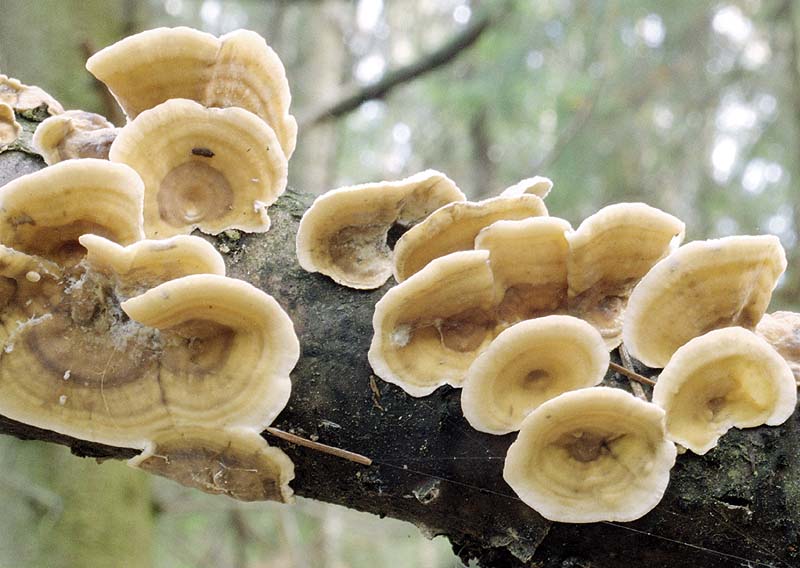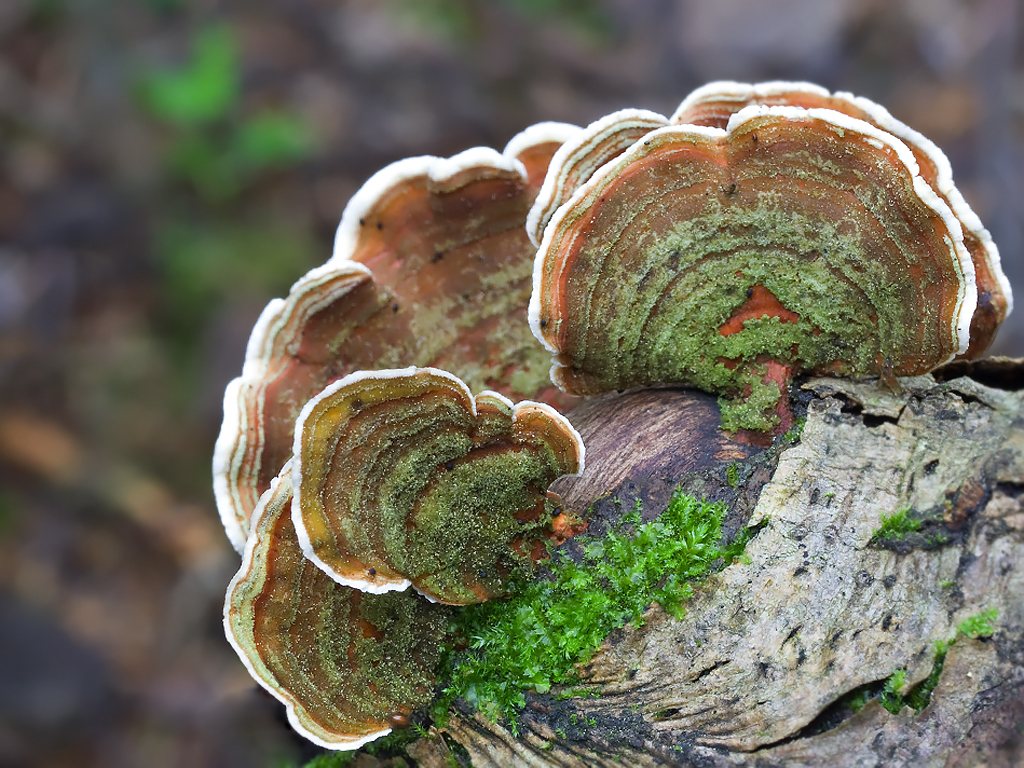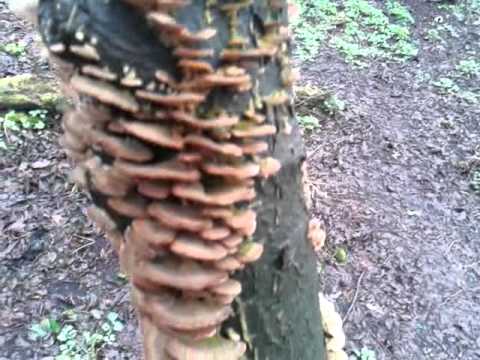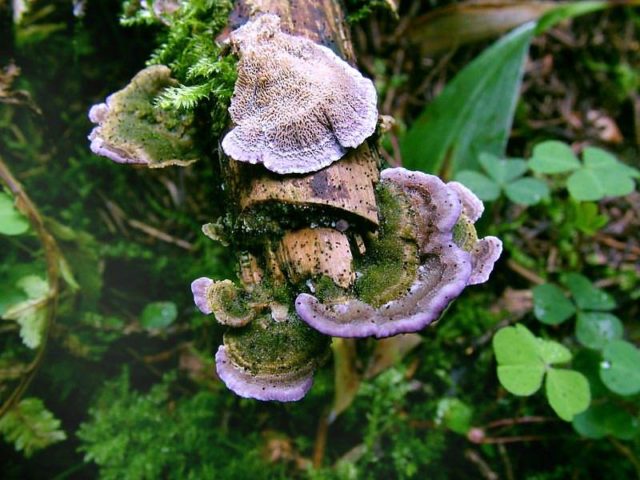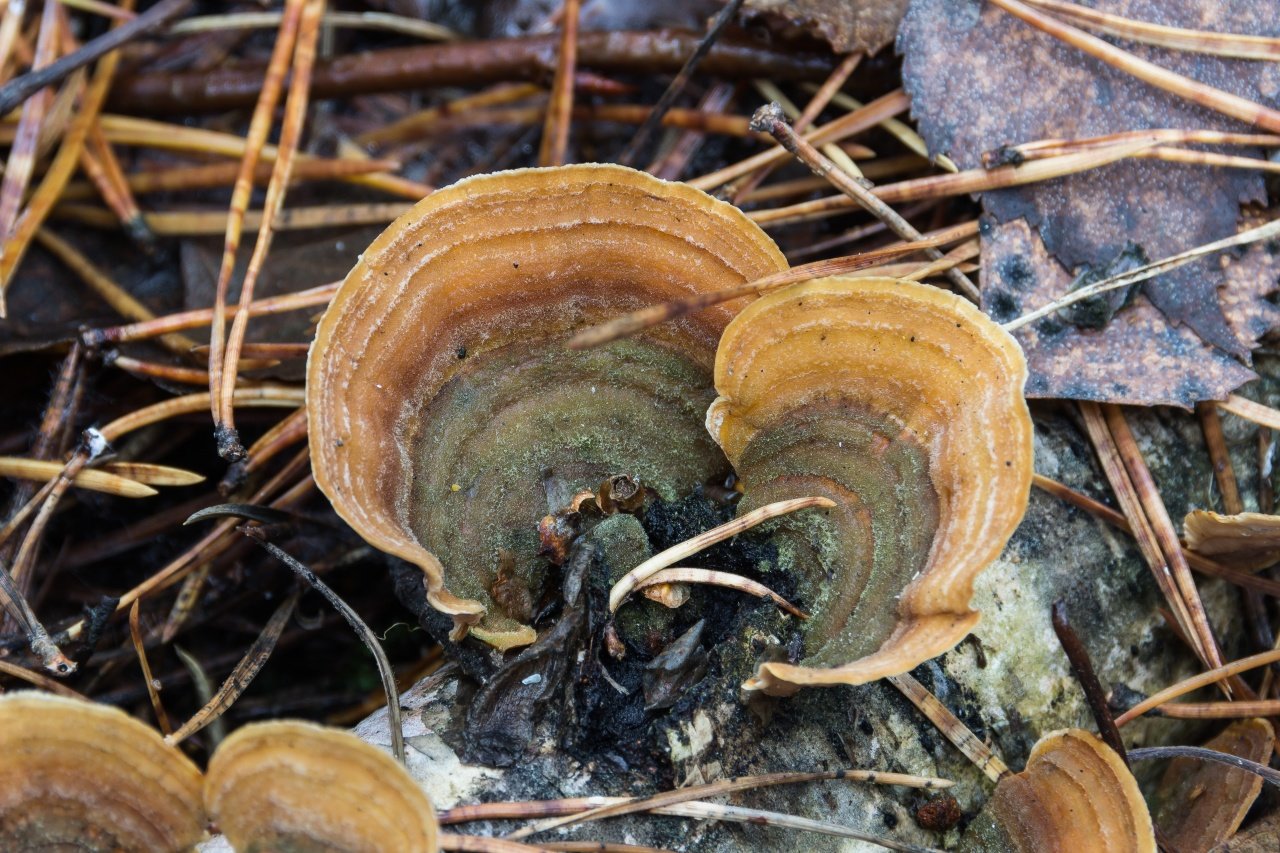Interesting Facts
It has been established that substances with anticarcinogenic and antimicrobial effects can be isolated from the fruit bodies of the coarse hairy stereum. However, their properties are under study.
Current title
| Index Fungorum | Stereum subtomentosum Pouzar | |
| MycoBank | Stereum subtomentosum Pouzar |
Systematic position
Etymology of the species epithet
Subtomentosus, a, um, mic. a bit like felt. From sub- a little, a little, a little + tomentum, i, n, stuffing made of wool, straw, etc.
Synonyms
- Stereum ochroleucum subsp. arcticum Fr., Hymenomyc. eur. (Upsaliae): 639 (1874)
- Stereum arcticum (Fr.) Mussat, in Saccardo, Syll. fung. (Abellini) 15: 402 (1901)
Other names: Felt Stereum, Weakly felt Stereum.
Habit
Fruit body: Sedentary, cantilever, hoof-shaped, in the form of an irregular growth or rosette
Hymenophore: Smooth, not pronounced
Fruiting body
Fruiting bodies are annual, growing in a row or in tiled groups, outstretched-bent, fan-shaped, attached to the substrate by a wide base, sometimes funnel-shaped or coiled like a shell, and attached to the substrate by a tapering lateral false stem. Neighboring blades often grow together sideways and envelop the stalks of grass, twigs, and various forest debris encountered on the way. Individual fruiting bodies up to 50 (80) mm in width, 30 - 70 mm from edge to base and about 1 mm in thickness. The edge is always light, sometimes almost white, wavy or lobed. The surface is velvety, thin-lined, brightly and contrastingly colored: concentrically zoned with stripes of different shades of red, brown, gray and almost black. In old age and in dry weather, the surface fades and fades. In humid habitats, green and blue-green algae settle on the fruit bodies, coloring the surface in green shades.
The hymenophore is smooth, slightly lumpy, dull, sometimes with concentrically located grooves, gray-yellow, light brown, light ocher, turns yellow in damaged areas.
Pulp
The pulp is fibrous, elastic, hard-leathery, yellow-ocher, ocher-brown. Smell and taste are mild.
Microscopy
Spores 5.5 - 6.5 × 2 - 3 μm, ellipsoid-cylindrical, smooth, hyaline.
Basidia 45 - 60 × 5 - 6 μm, narrow-clavate, 4-spore, without a buckle at the base.
There are no cystids; thick-walled terminal elements of skeletal hyphae ending in a rounded head 5 - 8 µm in diameter can be taken for them.
The hyphal system is dimitic, the generative hyphae are thin- and thick-walled, 2.5–4 µm in diameter; skeletal hyphae up to 8 µm in diameter, thick-walled.
Baffles without buckles.
Ecology and distribution
Substance: Woody plants (living trees, bark and dead wood)
Grows in groups on dead wood of many deciduous species. Causes white rot.
In Western Siberia, it lives mainly on birch, aspen, alder, willow. It is distributed from the northern taiga, where it occasionally occurs in burnt-out areas and in settlements, to the forest-steppe, where it becomes a background species.
Sterium is the cleanest database of quality ads that allows you to find housing, rent and sell properties quickly and safely. Show in full ...
Sterium refers to an ad as a quality ad that represents the object as fully as possible, contains detailed truthful information and is not the subject of spam, that is, multiple repetitions on the same site. On Sterium, real estate looks the same as in real life.
Only on Sterium, displaying any object takes no more than 5 minutes.
Thanks to the 3D tour in each ad, you can view the apartment without meeting the owner.
Thus, the time for viewing all the ads on the market that you are interested in is reduced significantly.
The result is a great deal.The seller and buyer, landlord and tenant do not waste time on meetings and shows and quickly find each other.
Dandelion
Even small children can easily recognize the good old dandelion. This perennial herb belongs to the multicolor family. It is characterized by a green stem, up to 60 cm long, pinnate toothed leaves emerging from a basal rosette and yellow baskets. The fruit is an achene with a tuft of light gray hairs.
It grows mainly in the forest-steppe zone. You can meet him in open spaces, for example, in fields, along rivers, ditches, and in almost every yard and vegetable garden, as well as in the forest at the edges and along forest paths.
The flower has a valuable composition, which includes protein, vitamins A, C, E. All its parts contain milky juice, due to which it has a bitter taste. You can eat it raw, but not everyone will like the bitterness present. To get rid of it, it is better to cook the plant, but if this is not possible, at least pour it over with a portion of boiling water or hold it for several hours in salt water. The leaves will fit well into a salad, and the root is best eaten boiled or fried. He will act as a completely satisfying dish. And if you dry it and grind it finely, you can get a healthy herbal tea.
Horse sorrel (wild sorrel)
Wild sorrel is an edible plant familiar to many. It is very similar to its small brother, the common sorrel. The difference lies in the size and structure of the leaves, which are much larger and stiffer in the equine species. The total plant height can reach two meters in height.
Due to the fact that the leaves are quite dense, they do not taste as good as the usual species, but they are quite edible. All parts of the plant are rich in tannins, essential oils, vitamins and trace elements. And if the root is better used for making decoctions, then the leaves and petioles can be eaten fresh, for example, as part of a vegetable salad.
It is often found in forest and forest-steppe zones, in meadows, and horse sorrel loves wet swampy areas.
Cytidia willow (stereum) where it grows, how it looks, photo, edibility
Cytidia willow (stereum): photo and description
| Name: | Cytidia willow |
| Latin name: | Cytidia salicina |
| View: | Inedible |
| Synonyms: | Stereum salicinum, Terana salicina, Lomatia salicina, Lomatina salicina, Cytidia rutilans, Auricularia salicina, Corticium salicinum, Thelephora salicina |
| Specifications: |
|
| Systematics: |
A representative of the family Kortidia willow cytidia (Stereum salicinum, Terana salicina, Lomatia salicina) is a wood-dwelling mushroom. It parasitizes the branches of old or weakened trees. Does not represent nutritional value, the mushroom is inedible.
Where does cytidia willow grow
A long-term microscopic fungus can exist only in symbiosis with willow, poplar, less often other deciduous species. The main distribution - on old weakened dying branches, also grows on new dead wood.
Cytidia willow is popular in warm and temperate climates. The main accumulation is in the forests of the Central regions, Siberia, and the Urals. In the Krasnodar Territory, it occurs in areas where there are mountains and the Black Sea forests near the coast, in warm climates it bears fruit throughout the year. In the climate of temperate latitudes, young fruiting bodies appear in the spring, growth lasts until a prolonged autumn. When the air humidity is high during the season, the fungus will cover large areas of the branches and trunk on which it parasitizes.
In winter, Cytidia is dormant, old fungi do not die for approximately 3-5 seasons, they continue to spread along with young specimens. In dry weather, dying fruit bodies lose moisture, become tough, dry out significantly, and acquire the color of wood. They can be seen only with a detailed examination of the branch section.
What does cytidia willow look like?
Willow cytidia has the usual macroscopic structure of the fruiting body with a different characteristic:
- the shape of an irregular circle, the transverse length is 3-10 mm, it happens in the form of a thin smooth continuous film that covers the wooden surface;
- color - bright red or burgundy with a purple tint;
- at low humidity, perennial specimens have a leathery wrinkled surface, during prolonged rains - a jelly-like consistency with an oily surface. Dry mushrooms - tough, horny, not losing color;
- location - sprawling, sometimes with raised edges, which are easily separated from the surface.
They begin to grow singly, for some time they form small groups in different places of the tree bark. Growing up, the groups are connected in a solid line, reaching up to 10-15 cm.
Is it possible to have willow cytidia
In biological reference books, Cytidia willow is in the group of inedible species. No toxicity information available. But the thin fruiting body, which is primarily tough when dry and jelly-like during precipitation, is unlikely to arouse gastronomic interest.
Similar species
Radial cytidia of willow phlebia is similar in appearance, mode of development and places of growth. It parasitizes dry deciduous trees, old dead wood.
A similar species stands out with a larger size of the fruit body, forms wide or long conglomerates. The color is closer to orange; in dry weather, a dark purple spot becomes larger from the central part and spreads to the edges. When freezing, it can completely turn black or colorless. Rounded shape with scalloped raised edges. The surface is bumpy. Mushrooms with a one-year growing season, inedible.
Usage
Fruit bodies are inedible, they are not used in any form for processing. They also have not found use in alternative medicine. In the ecological system, like any biological species, the fungus has a specific function. From symbiosis with dying wood, it receives useful microelements for development, on its part, it slows down the process of decomposition and decomposition of dead wood.
Conclusion
Saprotroph cytidia willow parasitizes on dry branches of deciduous trees, mostly willow and poplar. Forms long continuous conglomerates in the form of a red film. The mushroom is inedible, there is no information about poisonous compounds in the chemical composition.
What does cytidia willow look like?
Willow cytidia has the usual macroscopic structure of the fruiting body with a different characteristic:
- the shape of an irregular circle, the transverse length is 3-10 mm, it happens in the form of a thin smooth continuous film that covers the wooden surface;
- color - bright red or burgundy with a purple tint;
- at low humidity, perennial specimens have a leathery wrinkled surface, during prolonged rains - a jelly-like consistency with an oily surface. Dry mushrooms - tough, horny, not losing color;
- location - sprawling, sometimes with raised edges, which are easily separated from the surface.
They begin to grow singly, for some time they form small groups in different places of the tree bark. Growing up, the groups are connected in a solid line, reaching up to 10-15 cm.
view
C. hirsutum and S. Ostrea are members of a complex of species, some of which may not be reliably distinguished without microscopic analysis.
There are numerous species of this genus (and family), the most common one being far Stereum hirsutum .
- Stereum acanthophysatum
- Stereum adnatum
- Stereum albostipitatum
- Stereum alternum
- Stereum antarcticum
- Stereum aotearoa
- Stereum aratum
- Stereum armeniacum
- Stereum ear tweezers
- Stereum aurora
- Stereum avellanaceum
- Stereum azonum
- Stereum bagliettoanum
- Stereum beigehymenium
- Stereum Bellum
- Stereum bombycinum
- Stereum boninense
- Stereum braunii
- Stereum burtiasmum
- Stereum burtissimum
- Stereum campaniforme
- Stereum carthusianum
- Stereum complicatum
- Stereum cupulatum
- Stereum durum
- Stereum earlei
- Stereum elongatum
- Stereum fasciatum
- Stereum gausapatum
- Stereum hirsutum
- Stereum insignitum - can be considered synonymous Stereum subtomentosum
- Stereum ostrea - False turkey tail. Sometimes considered variety * Stereum hirsutum .
- Stereum papyrinum - Preferred title: Lopharia papyrina
- Stereum purpureum - Silver leaf fungus. Preferred name: Chondrostereum purpureum
- Stereum rugosum
- Stereum Blushing
- Stereum subtomentosum
- Stereum taxodii - Preferred title: Laurilia taxodii
Hard-haired stereum: photo and description, application
| Name: | Stereum coarse-haired |
| Latin name: | Stereum hirsutum |
| Type of: | Inedible |
| Specifications: |
|
The coarse-haired stereum is an inedible representative of the Stereumov family. It prefers to grow on stumps, dry wood, and living damaged trunks. The variety is widespread throughout Russia, bears fruit throughout the warm period. The mushroom is considered medicinal and is used in folk medicine.
Where the coarse-haired stereum grows
The variety grows on dry, deciduous and coniferous stumps. The coarse-haired stereum grows on rotten wood as a saprotroph, thereby playing the role of a forest orderly, and on living damaged trees as a parasite, causing a white gil. Damaged trunks begin to quickly collapse and die. The species grows in large groups, forming multi-tiered families in the form of wavy ribbons.
What does a hard-haired stereo look like?
The species is widespread throughout Russia; it can be identified by a small fan-shaped fruit body with outstretched-bent edges. The surface is hairy, pubescent, colored yellow-brown. After rain, it becomes covered with algae and takes on a slimy greenish tint. The underside is smooth, pale canary in color, with age it changes color to dark orange or brown. After frosts, in early spring, the surface becomes grayish-brown with light wavy edges. The fungus attaches itself to the wood with its entire lateral side, forming long, multi-tiered rows.
The species reproduces by colorless cylindrical spores, which are located in a white spore powder.
Is it possible to eat coarse-haired stereum
The coarse-haired stereum is an inedible species, as it has a tough cork pulp. There is no taste or smell. The mushroom begins to bear fruit from June to December; in regions with warm winters, it can grow all year round.
Similar species
Stereum harsh haired, like any variety, has twins. These include:
- Felt. The variety is distinguished by its large size, velvety surface and red-brown color. The fruiting body is attached to the substrate by a small part of the lateral side. The underside is matte, slightly wrinkled, gray-brown in color. The variety is inedible, as it has a tough cork pulp, odorless and tasteless. Distributed in the northern temperate zone, bears fruit throughout the warm period.
- Tinder fungus is sulfur-yellow, conditionally edible mushroom. In cooking, only young specimens are used, since the pulp has a pleasant sour taste. The species grows on live wood, not high above the ground. It can be recognized by a fan-shaped pseudo-hat measuring 10 to 40 cm. The surface has an orange-yellow color with a slight pink tint. The snow-white pulp in young specimens is soft and juicy, has a sour taste and a delicate lemon aroma.
- Trichaptum is a double, inedible mushroom. A small fruiting body is located on dead wood in multi-tiered groups. The pseudo-hat is semicircular, irregularly fan-shaped. The surface is felt, it becomes smooth with age. The color is light gray, brown or golden. Distributed throughout Russia. Bears fruit from June to September.
Application
Coarse-haired stereum has medicinal properties. The fruit body is distinguished by antitumor and antibacterial properties, therefore it is widely used in folk medicine. Decoctions and infusions stop the growth of cancer cells, fight malaria, help with Ehrlich's sarcoma and carcinoma. It is possible to use the gifts of this type of forest only strictly according to the rules, otherwise there is a great risk of poisoning.
Conclusion
Hard-haired stereum is an inedible variety of the Stereumov family. The species grows on dry and damaged wood, in deciduous and coniferous forests. Due to its medicinal properties, it is widely used in folk medicine.
Similar species
Stereum harsh haired, like any variety, has twins. These include:
- Felt.The variety is distinguished by its large size, velvety surface and red-brown color. The fruiting body is attached to the substrate by a small part of the lateral side. The underside is matte, slightly wrinkled, gray-brown in color. The variety is inedible, as it has a tough cork pulp, odorless and tasteless. Distributed in the northern temperate zone, bears fruit throughout the warm period.
- Tinder fungus is sulfur-yellow, conditionally edible mushroom. In cooking, only young specimens are used, since the pulp has a pleasant sour taste. The species grows on live wood, not high above the ground. It can be recognized by a fan-shaped pseudo-hat measuring 10 to 40 cm. The surface has an orange-yellow color with a slight pink tint. The snow-white pulp in young specimens is soft and juicy, has a sour taste and a delicate lemon aroma.
- Trichaptum is a double, inedible mushroom. A small fruiting body is located on dead wood in multi-tiered groups. The pseudo-hat is semicircular, irregularly fan-shaped. The surface is felt, it becomes smooth with age. The color is light gray, brown or golden. Distributed throughout Russia. Bears fruit from June to September.
Entoloma garden (Entoloma clypeatum)
- Other names for the mushroom:
- Entoloma edible
- Thyroid rosacea
- Entoloma thyroid
- Shield entoloma
- Thorny entoloma
- Entoloma forest
- Podlivnik
- Podrikosovik
- Podzherdelnik
OTHER NAMES:
DESCRIPTION:
The hat of an entoloma garden with a diameter of 7 to 10 (and even 12) cm.In youth it is bell-conical or convex, then unevenly spread and convex-concave, often with a tubercle, smooth, sticky in the rain, darker, in dry weather - silky fibrous, lighter. Its edge is uneven (wavy), sometimes with cracks.
The color of the cap varies from whitish-gray, beige and gray-brownish to grayish and gray-brown. The plates of the entoloma are wide, rather rare, adherent to the pedicle with a tooth, with a serrated edge, of unequal length.
In adolescence, entolomas are whitish, then they become pale pink, dirty pink or gray-brownish, and in old age they acquire a reddish tint. The pinkness of the plates is the main distinguishing feature of all enthol. A cylindrical, often curved, often twisted leg reaches a height of 10, sometimes 12 cm, in thickness - from 1 to 2 (and even 4) cm.It is brittle, longitudinally ribbed, solid, in old age, hollow, sometimes twisted, slightly under the cap furrowed.
The leg is whitish, pinkish or grayish in color. And its slightly thickened base is lighter. The ring on the leg is always missing. The pulp of entoloma is dense or soft, fibrous, white or brownish, with a weak mealy taste and smell, or even insipid.
Spore powder of pink color.

HABITATS AND GROWTH TIME:
Entoloma orchard grows in deciduous and mixed forests under rowan, birch and oak trees - on nutrient-rich soil, along roads, in meadows, in gardens and on city lawns. In the garden, it often grows under fruit trees (apple and pear) and bushes of roses, rose hips, hawthorns and blackthorns.
It is widespread and common on the territory of the Leningrad region and in St. Petersburg, although it grows pointwise - from the last five days of May to the end of July with the most massive fruiting in June and in a wet, cool summer - and in July. Often it gives not one, but several short layers. Garden entoloma rarely appears alone, usually grows in groups, often in large.
TWINS:
There is a very similar mushroom - edible entoloma pale brown (Entoloma sepium) with a creamy, brownish-gray and even gray-brownish-greenish cap, emarginate-descending plates, white, shiny, long-fibered stem. Grows on lawns, gardens and bushes from late May to June.
The main task is not to confuse these two edible entolomas with Entoloma sinuatum. The main differences between E.poisonous: a larger size (a cap up to 20 cm in diameter), a lighter (dirty whitish, creamy gray, grayish ocher and yellowish) cap with an easily removable skin, yellowish (in youth) plates, thicker (up to 3 cm in diameter), club-shaped stem, one-color with a cap, as well as a faint unpleasant smell of pulp. But this smell can be almost imperceptible. It is not found in the north of Russia.
There are two more relatively similar poisonous entolomes. Entoloma pushed through (Entoloma rhodopolium) with a thin yellow-cream, gray or brownish cap and ammonia odor. It grows from August to early October. And Entoloma spring - darker, shallow, slender and growing from the end of April to the last five days of May, that is, does not overlap with Entoloma Sadovaya in terms of timing.
EDIBILITY:
This is a conditionally edible mushroom. Boil entoloma for 20 minutes, and then put it in a roast, pickle or pickle. In southern Russia, dishes from it are from the category of traditional mushroom dishes, and in Western Europe, it is considered one of the best mushrooms.
Video about the mushroom Entoloma garden:
NOTES:
The word "clypeatum" in the name of the mushroom means "shaped like a shield." Widespread on the globe: Western Europe, Ukraine, European Russia and North America. Appears in warm regions in April. The genus Entoloma has 153 species, among them there are edible mushrooms, but in order to use them for food, you need to be an experienced mushroom picker. The clearest photographs and the best descriptions cannot save you from error, so be careful with these mushrooms!
Stereum subtomentosum
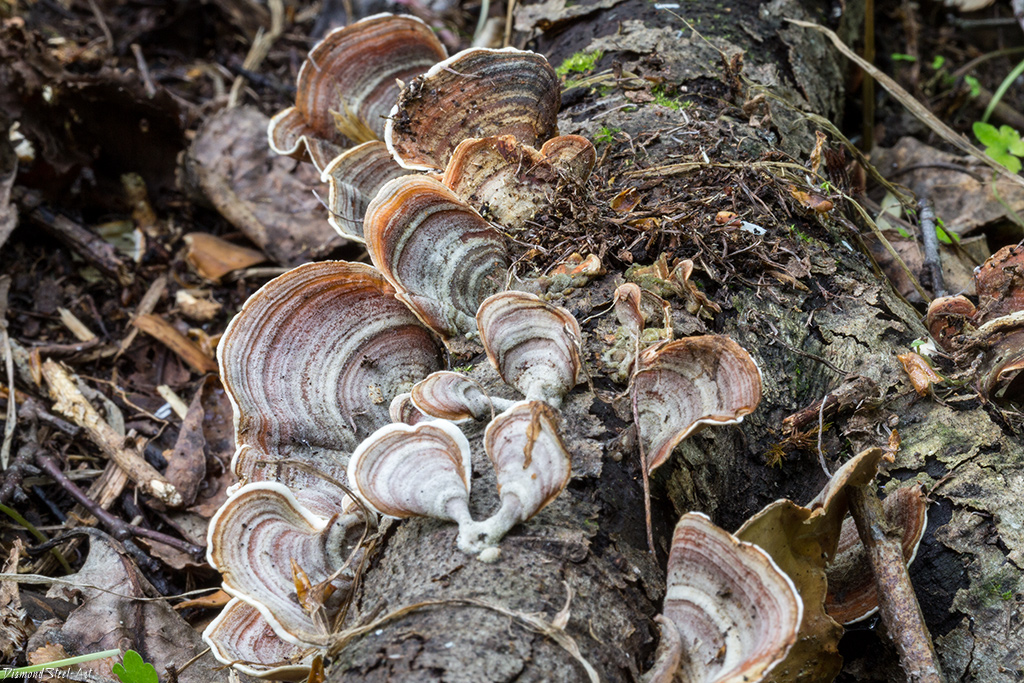
Current title
| Index Fungorum | Stereum subtomentosum Pouzar | |
| MycoBank | Stereum subtomentosum Pouzar |
Systematic position
Etymology of the species epithet
Subtomentosus, a, um, mic. a bit like felt. From sub- a little, a little, a little + tomentum, i, n, stuffing made of wool, straw, etc.
Synonyms
- Stereum ochroleucum subsp. arcticum Fr., Hymenomyc. eur. (Upsaliae): 639 (1874)
- Stereum arcticum (Fr.) Mussat, in Saccardo, Syll. fung. (Abellini) 15: 402 (1901)
Other names: Felt Stereum, Weakly felt Stereum.
Habit
Fruit body: Sedentary, cantilever, hoof-shaped, in the form of an irregular growth or rosette
Hymenophore: Smooth, not pronounced
Fruiting body
Fruiting bodies are annual, growing in a row or in tiled groups, outstretched-bent, fan-shaped, attached to the substrate by a wide base, sometimes funnel-shaped or coiled like a shell, and attached to the substrate by a tapering lateral false stem. Neighboring blades often grow together sideways and envelop the stalks of grass, twigs, and various forest debris encountered on the way. Individual fruiting bodies up to 50 (80) mm in width, 30 - 70 mm from edge to base and about 1 mm in thickness. The edge is always light, sometimes almost white, wavy or lobed. The surface is velvety, thin-lined, brightly and contrastingly colored: concentrically zoned with stripes of different shades of red, brown, gray and almost black. In old age and in dry weather, the surface fades and fades. In humid habitats, green and blue-green algae settle on the fruit bodies, coloring the surface in green shades.
The hymenophore is smooth, slightly lumpy, dull, sometimes with concentrically located grooves, gray-yellow, light brown, light ocher, turns yellow in damaged areas.
Pulp
The pulp is fibrous, elastic, hard-leathery, yellow-ocher, ocher-brown. Odor and taste are mild.
Microscopy
Spores 5.5 - 6.5 × 2 - 3 μm, ellipsoid-cylindrical, smooth, hyaline.
Basidia 45 - 60 × 5 - 6 μm, narrow-clavate, 4-spore, without a buckle at the base.
Cystids are absent; thick-walled terminal elements of skeletal hyphae ending in a rounded head 5 - 8 µm in diameter can be taken for them.
The hyphal system is dimitic, the generative hyphae are thin- and thick-walled, 2.5–4 µm in diameter; skeletal hyphae up to 8 µm in diameter, thick-walled.
Baffles without buckles.
Ecology and distribution
Grows in groups on dead wood of many deciduous species. Causes white rot.
In Western Siberia, it lives mainly on birch, aspen, alder, willow. It is distributed from the northern taiga, where it occasionally occurs in burnt-out areas and in settlements, to the forest-steppe, where it becomes a background species.
How does a wrinkled stereo look
The variety has a flattened, tough fruiting body. With massive growth, they grow together, organizing long wavy ribbons. You can find them out by the varietal description.
They can have a different appearance:
- The rounded edges are thickened into a small ridge.
- The flat fruit body has a rough surface and wavy, folded edges. The width of the folded edge is not more than 3-5 mm. The hard surface is covered with a dark brown paint with a pronounced lightened stripe along the edge.
- Less common is a mushroom located on a tree in the form of caps with a common common base.
The bottom part is even, sometimes with small bulges, covered with cream or light yellow paint, turns into pink-brown with age. In dry weather, the fruit body hardens and cracks. In case of mechanical damage, red milky juice is released. This reaction occurs even in dried specimens if the fracture site is soaked in water in advance.
The pulp is tough or corky, gray in color, has no smell or taste. On the cut of old specimens, thin annual layers are clearly visible.
Reproduction occurs with transparent long spores, which are located in a light yellow spore powder. It bears fruit during the entire warm period.
Stereum subtomentosum
Current title
| Index Fungorum | Stereum subtomentosum Pouzar | |
| MycoBank | Stereum subtomentosum Pouzar |
Systematic position
Etymology of the species epithet
Subtomentosus, a, um, mic. a bit like felt. From sub- a little, a little, a little + tomentum, i, n, stuffing made of wool, straw, etc.
Synonyms
- Stereum ochroleucum subsp. arcticum Fr., Hymenomyc. eur. (Upsaliae): 639 (1874)
- Stereum arcticum (Fr.) Mussat, in Saccardo, Syll. fung. (Abellini) 15: 402 (1901)
Other names: Felt Stereum, Weakly felt Stereum.
Habit
Fruit body: Sedentary, cantilever, hoof-shaped, in the form of an irregular growth or rosette
Hymenophore: Smooth, not pronounced
Fruiting body
Fruiting bodies are annual, growing in a row or in tiled groups, outstretched-bent, fan-shaped, attached to the substrate by a wide base, sometimes funnel-shaped or coiled like a shell, and attached to the substrate by a tapering lateral false stem. Neighboring blades often grow together sideways and envelop the stalks of grass, twigs, and various forest debris encountered on the way. Individual fruiting bodies up to 50 (80) mm in width, 30 - 70 mm from edge to base and about 1 mm in thickness. The edge is always light, sometimes almost white, wavy or lobed. The surface is velvety, thin-lined, brightly and contrastingly colored: concentrically zoned with stripes of different shades of red, brown, gray and almost black. In old age and in dry weather, the surface fades and fades. In humid habitats, green and blue-green algae settle on the fruit bodies, coloring the surface in green shades.
The hymenophore is smooth, slightly lumpy, dull, sometimes with concentrically located grooves, gray-yellow, light brown, light ocher, turns yellow in damaged areas.
Pulp
The pulp is fibrous, elastic, hard-leathery, yellow-ocher, ocher-brown. Smell and taste are mild.
Microscopy
Spores 5.5 - 6.5 × 2 - 3 μm, ellipsoid-cylindrical, smooth, hyaline.
Basidia 45 - 60 × 5 - 6 μm, narrow-clavate, 4-spore, without a buckle at the base.
There are no cystids; thick-walled terminal elements of skeletal hyphae ending in a rounded head 5 - 8 µm in diameter can be taken for them.
The hyphal system is dimitic, the generative hyphae are thin- and thick-walled, 2.5–4 µm in diameter; skeletal hyphae up to 8 µm in diameter, thick-walled.
Baffles without buckles.
Ecology and distribution
Substance: Woody plants (living trees, bark and dead wood)
Grows in groups on dead wood of many deciduous species. Causes white rot.
In Western Siberia, it lives mainly on birch, aspen, alder, willow.It is distributed from the northern taiga, where it occasionally occurs in burnt-out areas and in settlements, to the forest-steppe, where it becomes a background species.
Interesting facts about the mushroom
Young specimens of flutter outwardly resemble bird eggs that have fallen out of the nest. Mushroom pickers discover their mistake only when they try to lift such an "egg" and find a small leg in it.
It is not recommended to collect flaps after rain. Like all raincoats, this species absorbs moisture, so instead of a mushroom, you can get a soggy mass.
Porkhovka contains special enzymes, thanks to which the mushroom is used to treat cancer.
Porkhovka is rich in vitamins, macro- and microelements. The mushroom contains vitamins B1, B2, B3, B6, B9, D, E, C potassium, magnesium, phosphorus, calcium and zinc. This mushroom is advised to be eaten with mental fatigue, severe fatigue, anemia, uremia. It is good for inclusion in the diet of vegetarians and those who do not eat meat, as it contains the proteins the body needs, as well as fats and carbohydrates, so that flap can be a complete substitute for meat and meat products.



